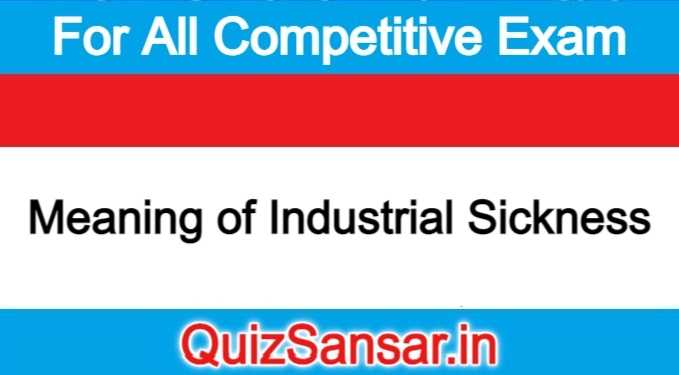
Meaning of Industrial Sickness
The strength of the industrial sector, by and large, determines the soundness of the economy.
A developing economy like India cannot afford the growing sickness in industries as it results in a colossal wastage of physical, financial and human resources. In the presence of the resource crunch, the industrial sickness becomes all the more an alarming problem. Industrial sickness usually refers to a situation when an industrial firm performs poorly, incurs losses for several years and often defaults in its debt repayment obligations.
The Reserve Bank of India has defined a sick unit as one “which has incurred a cash loss for one year and is likely to continue incurring losses for the current year as well as in the following year and the unit has an imbalance in its financial structure, such as, current ratio is less than 1: 1 and there is worsening trend in debt-equity ratio.” The State Bank of India has defined a sick unit as one “which fails to generate an internal surplus on a continuous basis and depends for its survival upon frequent infusion of funds.”
However, prior to the enactment of Sick Industrial Companies Act (SICA) in 1985, there was no agreement on the criteria to be used to describe an industrial unit as sick. According to SICA, as amended in 1992, an industrial company can be declared as sick which has at the end of any financial year accumulated losses equal to or exceeding its entire net worth. It may be noted that Sick Industrial Companies Act (SICA) applies to registered companies which have been in existence for at least 5 years.
In case of small scale industrial unit (SSI), it is regarded as a sick unit if it has:
(i) Incurred a cash loss in the previous accounting year and was likely to continue with losses in the current accounting year and further its cumulative cash losses are equal to 50 per cent or more of its peak net worth during the last five years and
(ii) It has defaulted in meeting four consecutive installments of
interest. According to the Development Commissioner, a small scale industrial unit (SSI) becomes sick if its:
(a) Capacity utilisation is less than 50 per cent of the highest achieved during the preceding five years (incipient sickness)’,
(b) Net worth has been eroded by more than 50 per cent; and (c) The unit has remained closed for a period more than six months.
On the basis of the above definitions of a sick industrial unit, it emerges that the symptoms of the sickness of an industrial unit manifest themselves in the form of unbalanced financial structure, erosion of more than 50 per cent of its net worth, absence of the generation of internal surplus, under- utilisation of capacity and survival of the unit upon frequent infusion of funds.
Causes/ Symptoms of Industrial Sickness:
The causes which are mostly responsible for industrial sickness in India are broadly classified into (a) external and (b) internal causes. The following are some of the external and internal causes of industrial sickness:
External Causes:
The external causes of sickness include:
(a) Power cuts imposed by the state governments; (b) Scarcity of raw materials and other inputs due to its erratic supply:
(c) Recession in the market resulting from steep fall in the quantum of demand for industrial products aggravated by credit restraints and resulting in unsold stocks and losses to industrial units; and
(d) Frequent changes in the government policy in connection with industrial licensing, taxation, power tariff, imports, exports etc. All these external factors are equally responsible for growing sickness among the industrial units of the country.
Internal Causes:
The internal causes which include various factors related to the industrial units itself include:
(a) Faulty location of industrial unit;
(b) Faulty planning of the production in the absence of market analysis;
(c) Defective selection of plants and machineries and adoption of obsolete technology particularly in the small scale sector;
(d) Acute financial problem due to weak equity base and lack of adequate support from banks;
(e) Incompetent entrepreneurs having no knowledge about costing, marketing, accounts etc;
(f) Labour problems like strikes and lock-outs arising from strained industrial relation over the issues like wages, bonus, industrial discipline etc; and
(g) Management problems resulting from managerial decisions in connection with production, marketing, finance, materials, maintenance, personnel management etc.
In 1984, the Tiwari Committee submitted its report on industrial sickness in India. In its report he identified the faulty management as the most important cause of sickness. Thus the committee concluded that, “Taking into account the finding of all the studies a broad generalisation regarding important causes of industrial sickness emerges.
It is observed that the factor most often responsible for industrial sickness can be identified as ‘management. This may take the form of poor production management, poor labour management, lack of professionalism, dissensions within management, or even dishonest management.
The Economic Survey, 1996-97, while underlining the causes of industrial sickness, observed that “The reasons for industrial sickness are internal factors such as project appraisal deficiencies, project management deficiencies and several external factors like shortage of raw materials, power crisis, transport and financial bottlenecks, changes in Government policy, increase in overhead cost etc. Marketing problems in the form of market saturation, product obsolescence and demand recession are also to be held responsible.”






